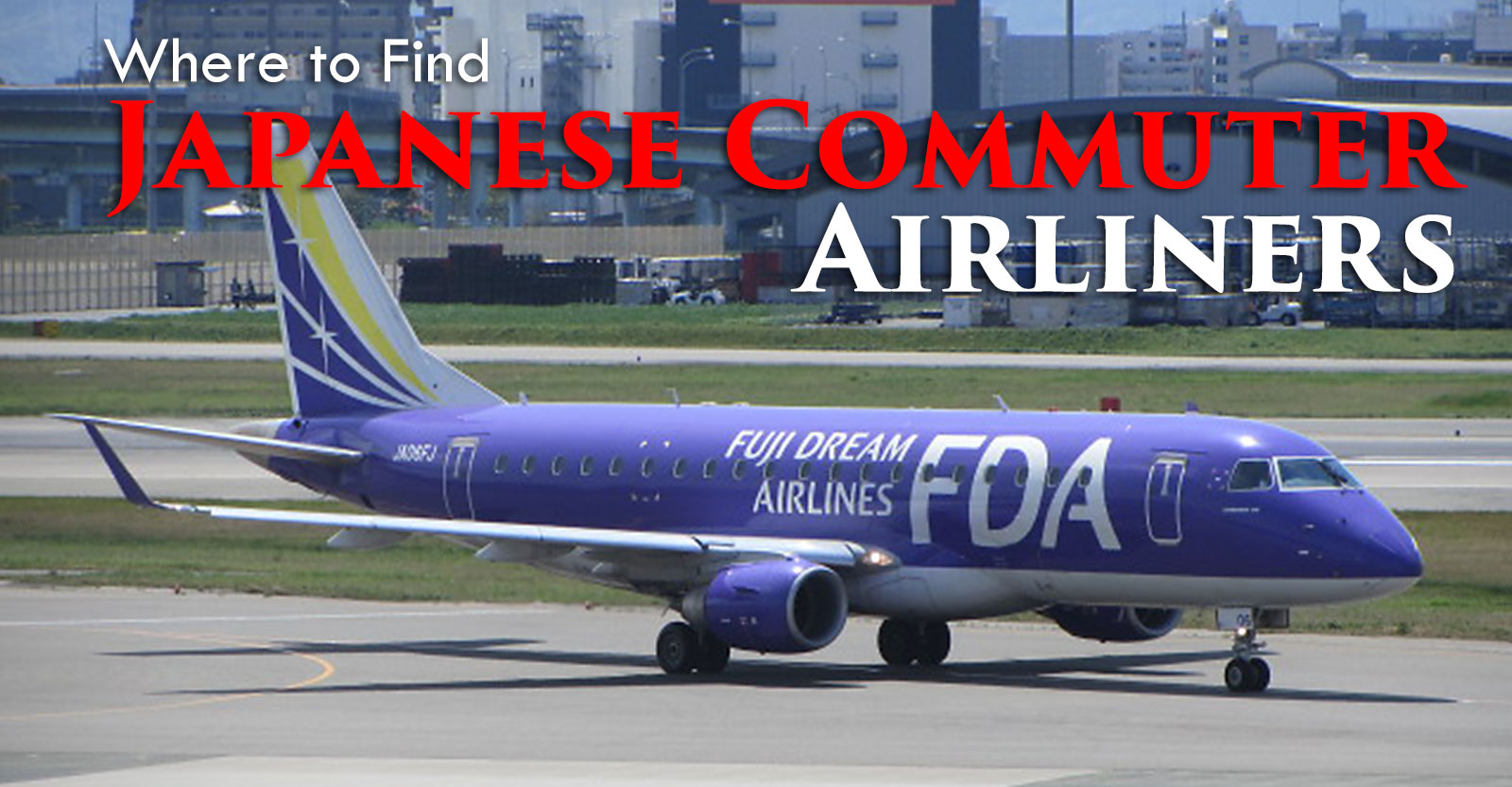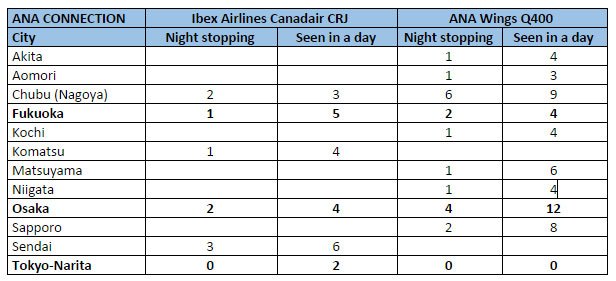Mark Curran has put together this useful guide to where to find Japanese commuter airliners for those planning on visiting the country.
Japan is a welcoming country for plane spotters and aircraft photographers, with excellent viewing terraces provided in not just every airport, but every terminal. The majority of airlines still produce printed timetables which provide a wealth of information. With the spotter typically visiting Tokyo, not many of the country’s commuter airliners and regional jets will be seen. I have therefore used the printed timetables to establish where the commuter aircraft night stop and where they fly. This is a summary of those results. It was compiled from Summer 2015 timetables, but there haven’t been any substantial fleet changes since then.
J-AIR
J-Air is the regional affiliate of Japan Airlines. There are 15 lines of flying on their Embraer 170 fleet of which nine night stop at Osaka and some 13 lines of flying pass through Osaka each day. Tokyo Haneda sees two night stopping aircraft and three lines of flying each day, with multiple visits from the same aircraft. Otherwise, Fukuoka and Sapporo are the other major cities the J-Air Embraer 170s occasionally visit, whilst night stoppers are also at Kagoshima and Sendai.
Osaka is also the busiest airport for the J-Air Canadair Regional Jet fleet, with the majority visiting each day although only three night stop. Sapporo, in the north of Japan, sees very few Embraers but six different CRJs each day. The rest of J-Air CRJ service connects Sendai, Miyazaki and Kumamoto to smaller cities.
Therefore the best place to see the J-Air fleet is undoubtedly Osaka.
JAPAN AIR COMMUTER
If ever there was a fleet that stays away from the major cities it is the Japan Air Commuter fleet of Dash 8-Q400s. Only two night stop at Osaka, the hub of other Japan Air Lines owned commuter operations, with another two at Fukuoka. The majority overnight at Kagoshima, where six lines of flying can be seen daily. Miyazaki is the only other city to see these Q400s in any numbers.
Kagoshima and Fukuoka are also the largest cities to see the JAC Saab 340 fleet. Four aircraft night stop at Kagoshima, three at Fukuoka and one at Kakaijima. Operations though are centred on Kagoshima and the western end of Japan. There are ten Saabs in the fleet, which I expect the spare aircraft are to be found at Kagoshima, and which are due to be replaced by slightly larger ATR42-600s.
RYUKYU AIR COMMUTER
The five Dash 8s of Ryukyu Air Commuter are based at Naha, Okinawa province, and are used for local flying within the islands off Naha. These and the JTA 737-400s are the principal airliner attraction at Naha, which is also a JASDF base (substantial deployment of P-3s and F-15s amongst other types) and Japan Coastguard (Falcon 900, Dash 8 and helicopters). RAC are to replace their fleet with the first Dash 8-400 Combis, the first of which (c/n 4505) is in flight test at Downsview.
AMX AIR
AMX Air operate a schedule that requires a single aircraft, and have just transitioned from their Dash 8 to a new ATR42-600. It serves Fukuoka three times per day from Amakusa.
ORIENTAL AIR BRIDGE
Oriental Air Bridge operate a pair of Dash 8-200s from Nagasaki. They make two daily visits to Fukuoka from Gotofukue at 11:55 and 16:15 and should be different aircraft. The other destinations for Oriental Air Bridge will be well off the spotters’ itinerary!
HOKKAIDO AIR COMMUTER
Hokkaido Air Commuter operate three Saab 340s from the downtown Sapporo-Okadema airport to destinations around Hokkaido island. This is a different airport to Sapporo-New Chitose International which all other airlines to Sapporo serve. There isn’t much else at Okadema and is quite a trek from New Chitose.
ANA CONNECTION
ANA Connection is operated by Ibex Airlines Canadair Regional Jets and ANA Wings Dash 8-Q400s.
Ibex, formerly known as F’air now has two CRJ-200s (from a peak of four) and seven CRJ-700s, which tend to operate from Sendai, Osaka and Fukuoka to secondary cities morning and evening, and fill in some flights between larger cities during the day. Of the major cities, Fukuoka and Osaka see several aircraft per day whilst Sendai is the principal centre of operations. There are two flights in the afternoon in to Tokyo Narita on the CRJ-700.
ANA Wings operate nineteen lines of flying on twenty Dash 8 Q400s. Like the JAC Q400s they are quite well spread out with nine night stopping locations. The fleet does get about, there do not appear to be any ‘there and back several times a day’ type operations, so where multiple aircraft visit an airport each day it may only be once. Nonetheless the busiest airports for the ANA Wings Q400s are likely to be on the spotters’ agenda, namely Nagoya-Chubu (Centrair) and Osaka-Itami. Like the JAC fleet these do not visit Tokyo.

Ibex Airlines CRJ700 arriving at Fukuoka’s domestic terminal (itself with two viewing decks): the impressive international terminal (with a substantial viewing deck as well) is in the background.
FUJI DREAM AIRLINES
Fuji Dream Airlines (FDA) have eight lines of flying for nine Embraer 170/175 aircraft, each painted in a unique all over livery. Of these six night stop at Nagoya-Komaki and two at Shizuoka. During the course of the day seven aircraft should visit both Komaki and Fukuoka, although the latter is mainly single visits whereas the former is the home of FDA with multiple visits from each aircraft. FDA is the only airline operating at Komaki, although it is an active Japan Air Self Defense base with based Hercules, 767 and BAe 125 aircraft, as well as being the home of Mitsubushi Heavy Industries, undertaking maintenance on multiple types as well as production of the new MRJ regional jet.
The only other major airport served by FDA is Sapporo, which sees one or two aircraft per day depending on the day. FDA ticket desks provide details of which aircraft is operating which flight, with a departure board showing the colour scheme of each aircraft.

The Fuji Dream Airlines departure board at Fukuoka showing which aircraft is due to operate which flight. It can be seen that a good proportion of the fleet will pass through Fukuoka each day, although the main base and centre of operations is Komaki.
JAPAN COAST GUARD
The Japan Coast Guard operate nine DHC-8-300s and four Saab 340s (amongst other corporate jet and helicopter types) made up of a mix of new build and second hand aircraft, the latter primarily ex Air Nostrum Dash 8s. They tend to work to fixed bases and are frequently seen outside hangars or flying regularly.
JAPAN TRANSOCEAN AIR
Whilst not a commuter carrier, the Japan Transocean Air fleet of 737-400s will not routinely be seen in Tokyo. They are based at Naha, in Okinawa province, at the southern tip of Japan about 2 hours’ flying time south of Fukuoka. The JTA fleet does visit some mainland cities notably Fukuoka (6 daily flights), Osaka (3) and Nagoya (4), but flights from Haneda, of which there are some 14 daily, are operated by JAL 767 and 777 aircraft. Note that Japan Transocean have 737-800s on order to replace their current fleet of -400s.














3 comments
Missing from the report is….
NEW CENTRAL AVIATION
The New Central fleet of five Dornier 228s operate flights from Tokyo’s Chofu airport to islands south of Tokyo. Four aircraft are required to operate the schedule. Chofu is located in western Tokyo, about one mile walk from Tama station on the Seibu-Tamagawa line. To get here use the JR Chuo Line from Tokyo-Shinjuku and change. Shinjuku is also the terminus for the train to Sayama-shi, the station for Iruma AB. The Dorniers all go out about 0900 and are back at 1600, timetable here http://www.central-air.co.jp/timetable.html. Mark
wonderfully information.
[…] [Read our guide: Where to Find Japanese Commuter Aircraft] […]